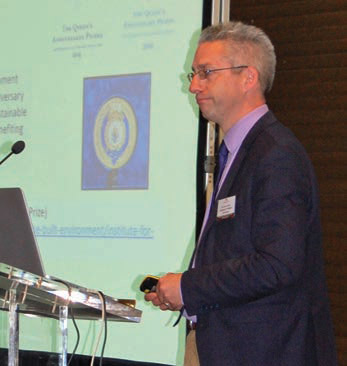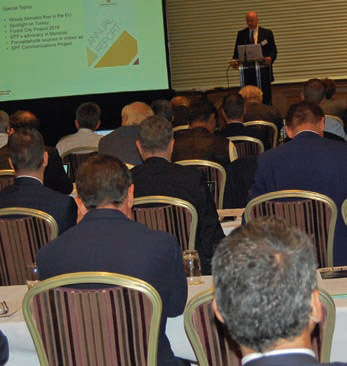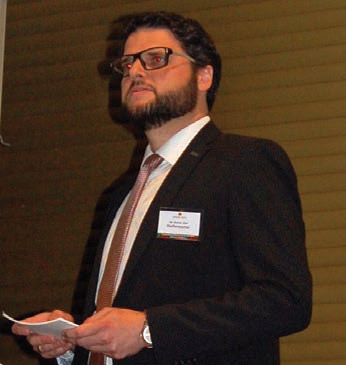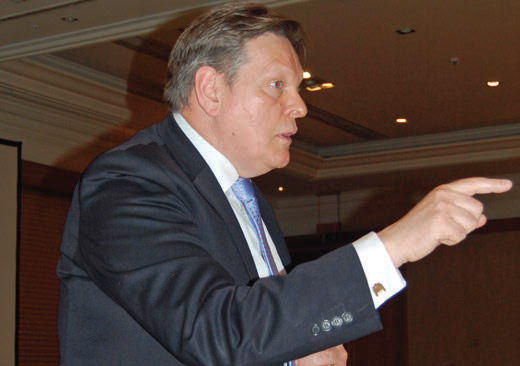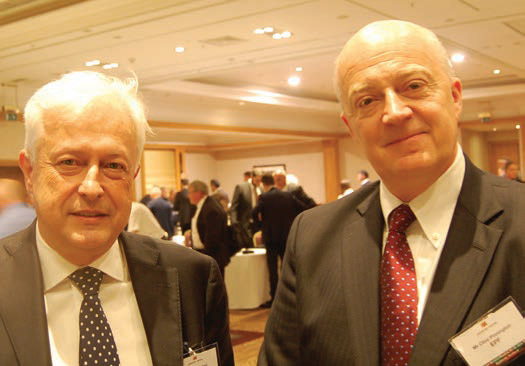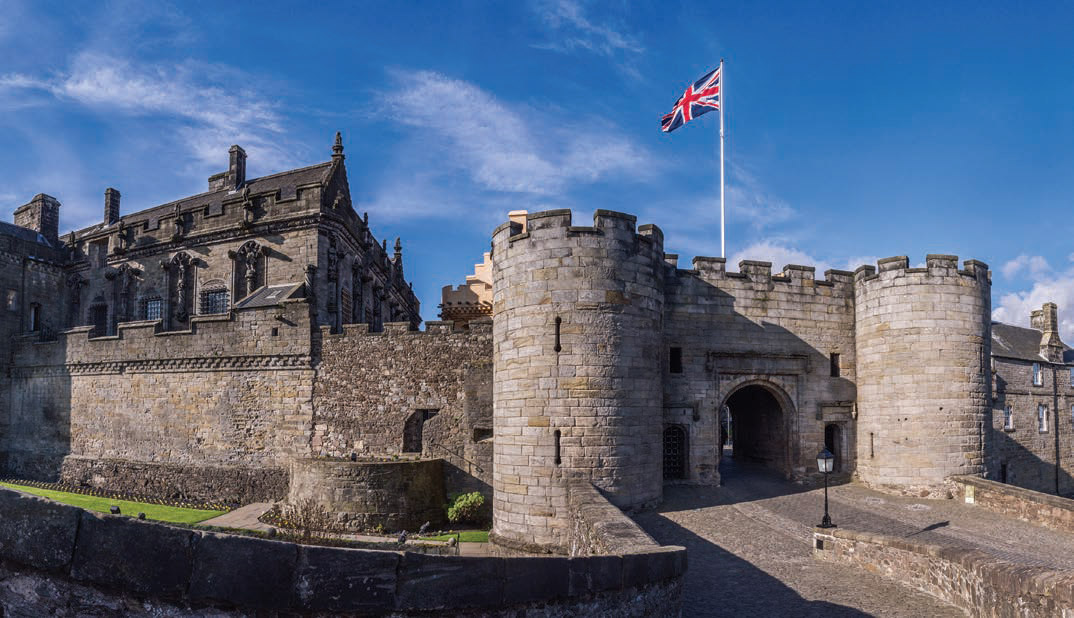The Big Board Talk
25 September 2019Panel producers and suppliers to the industry gathered in Scotland for the important European Panel Federation AGM. Stephen Powney attended and brings this report
This year Scotland was the setting for the European Panel Federation’s (EPF) annual general meeting, with UK panel producer Norbord hosting the event.
Norbord’s Cowie plant can be seen from the iconic Stirling Castle, ancestral home to the Scottish monarchy, where the annual dinner was held on June 27 and attended by several hundred representatives of the European and global panels sector.
A thought-provoking conference once again formed the open session of the AGM, held at Hilton Dunblane Hydro the following day, with presentations including sessions from Professor Sean Smith from Napier University and local Stirling Member of Parliament Stephen Kerr, who raised the Brexit issue.
Professor Smith spoke on timber construction, telling delegates that architects were actively specifying timber products for reasons including climate change but there are also challenges and he signalled a need for innovation.
He said timber frame construction in new housing in Scotland had about a 75% market share, with a growing appreciation of the build method's advantages such as energy efficiency.
The country has a £500m offsite construction industry.
In England, he added, timber frame construction had moved up to about 25% of new built homes.
But Mr Smith said new regulations following the Grenfell Tower fire in London in June 2017 meant wall assemblies for new buildings over 18m high could not be in timber, even if it was CLT.
“Many of us are very disappointed with Dame Judith Hackett’s report because they seemed to have jumped the gun and gone after construction systems," he said. "I hope there will be some change to the regulations.”
Professor Smith said timber and wood based panels would have a strategic role to play in the future and cited global housing need as a big driver for growth in wood construction. He said global housing need in the next 80 years was equal to 6.25 times Europe’s housing total.
Next speaker, Frank Goecke, senior principal, Pöyry Management Consulting, also looked into timber construction, as well as dynamics in the global panels industry. Mr Goecke said that China added 8 million m3 of particleboard capacity in the last three years, while global net capacity had risen by the same amount over the same period.
The first new particleboard line to be installed in North America for some time has now started up, with Mr Goecke predicting more to come in the future as companies update their production facilities.
He reported particleboard manufacturing industry stagnation in western Europe and he expects some facilities to close in the coming years.
But with MDF he said investments were taking place at plants across all the regions but again a stagnation of capacity in western Europe.
Global OSB net capacity increased by 4.5 million m3 in the last three years, while the Chinese plywood manufacturing sector had seen thousands of small mills close down because of new environmental regulations.
Mr Goecke reported that capacity utilisation has improved in China and the country was also moving towards using waste wood to make particleboard because they don't have sufficient wood of their own.
Global panel manufacturing leader Kronospan has over 25 million m3 capacity in all panel products and is on its way to 30 million m3 in the coming years, with particleboard and MDF taking up 70% of its installed capacity and OSB/plywood at 30%.
Mr Goecke signalled a large spike in future wood product consumption in the future. He said assuming wood-based panels’ current 1% share of the global construction materials sector would increase to 1.5% in the future, additional demand of panels in construction markets would be 45 million m3, which is alone twice the capacity of OSB in North America.
“That would mean a lot of production lines would need to be installed to meet demand.”
Mr Goecke pointed out that architects were working more and more with “solutions”, not just a product, citing LVL, CLT and Magnum Board, which is several layers of OSB4 laminated together into a building panel.
He cited the W350 project – a tentative Japanese 350m-high/70-storey building plan using 90% wood and 10% steel in the structure. Some 185,000m3 of wood is planned to be used in the structure, including 10,000m3 of plywood and OSB.
He said LVL and Magnum Board is a potential way forward for the wood based panels industry and perhaps Magnum Board used in combination with CLT.
EPF managing director Clive Pinnington put the question to EPF members about the panel industry not benefitting from CLT’s popularity, as it was based on solid wood.
“Do we ride the wave and have our own solutions?” he asked.
European Stats
Mr Pinnington outlined statistics on the European panels industry Particleboard production reached 32 million m3 in EU28 and EFTA in 2018, a 2.6% growth, with capacity increasing by 3.1%.
Germany continues to be the largest player in the particleboard sector with an 18% market share, followed by France (11%) and Poland (9%), while furniture is the largest end use industry consuming 67% of output, with construction accounting for 21%.
Mr Pinnington said the second half of 2018 proved to be quite a difficult year for MDF, with production contracting by 0.5% to 12.3 million m3, following growth of 1.5% in 2017.
The laminate flooring industry was particularly under pressure in the second half of 2018.
European MDF capacity grew by 2.7% in 2018, with Germany having the leading market share (27%), followed by Poland (19%). Furniture was the largest end user industry, accounting for 67% of production. OSB production also dipped in 2018 – a 1.6% reverse to 6.19 million m3, while capacity grew by 3%.
Germany was the market leader with 18% of European production, followed by Romania (15%) and Poland (12%). Construction accounted for 87% of products.
Russia dominates the hardboard industry, accounting for almost half of European production. Output last year grew by 1% to 530,000m3. DIY markets account for 23% of customer markets.
Softboard recorded another strong year in 2018 with production increasing by nearly 6%, following on from earlier strong growth in 2017, as wood fibre insulation board products grow in popularity. Indeed, construction accounted for 75% of products.
Total EU softboard production was 5.8 million m3, with capacity rising by 1.6%.
“This is definitely an area that we expect to grow as climate-friendly construction continues to grow across Europe,” added Mr Pinnington.
European plywood production was described as growing at a “fine pace”. After strong growth of over 7% in 2017, last year saw a further 1.7% growth to 3.2 million m3. Total European wood based panels production for 2018 was 59.3 million m3, a 1.7% growth from the 58.3 million m3 recorded in 2017.
EPF technical director Kris Wijnendaele then provided an advocacy update to delegates.
On formaldehyde, he said different EU states have their own regulations but the EPF would like to see harmonisation.
The European Chemicals Agency has recommended a universal system for formaldehyde limits, with the test process under way. Implementation is predicted in 2022 but limit levels are still being debated.
Mr Wijnendaele said the EPF wanted to see more wood panels used in construction applications. “The solid wood industry with CLT is trying to have that all for itself."
The EPF is looking to form a small working group to network and lobby on this and other applications for panels.
A new EPF website has been introduced and the federation is also part of a forest industries based Vision 2050, contributing towards a clean planet for all – covering growing the role of wood, substituting CO2 and improving resource efficiency.
“I personally think this is a great project and I’m delighted the EPF is a part of it,” added Mr Pinnington. “We really have some allies at the top and we are very excited about it.”
Stefan Zipf, general manager, business unit wood, Dieffenbacher, then covered the future of machinery in the next 20 years.
Mr Zipf highlighted “disruptive innovations”, with innovation focused on digitalisation. Companies that fail to keep up with new digital technology will find themselves in a more difficult position in 2025, he warned.
“Digitalisation and services will drive the future,” he said.
With the increasing digitalisation of industry, more machine connectivity and enhanced data transfer, there was inevitably the question about data security for manufacturers.
“We are open to finding solutions to that and we are still at the beginning of the journey,” said Mr Zipf.
He also highlighted next generation OSB using recycled wood in the core – so called hybrid products – as having growing potential for the future.
In addition, of the eight to nine plant installations that Dieffenbacher averages annually, Mr Zipf said two were already aimed at producing panel products using straw-based raw material.
Raising Efficiency
Next up was Ralph Lunkwitz of BASF, who detailed the company’s Kauranat binding agent to raise the efficiency of particleboard production. The pMDI-based (polymeric diphenylmethane diisocyanate) product works synergistically with amino resins, such as those of the Kaurit brand. By combining the binding agents into a hybrid system, Mr Lunkwitz said the curing properties enable a significant increase in short press time, resulting in increased productivity.
George Gallagher, vice-chairman of Formacare, gave a positive perspective on formaldehyde, the current regulations on exposure limits and co-operation between EPF, Formacare and European agencies.
And final speaker of the day was Stirling MP Stephen Kerr, also chairman of the All Party Parliamentary Group for the wood panel industry, who gave a passionate presentation and revealed that he had voted to leave the EU due to what he called increasing federalisation and integration of the EU. He wanted to see a sensitive and orderly EU exit. “The process is a mess though,” he admitted.
He advocated greater lobbying by the British government to press the UN to drive increased tree planting across the world to provide material for the big increase in demand for wood.The 2020 EPF AGM will be held in Berlin.
